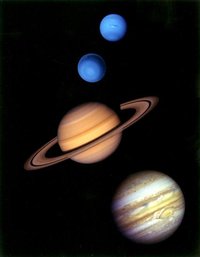Gas giant
|
|
A gas giant is a large planet that is not composed mostly of rock or other solid matter. Gas giants may still have a rocky or metallic core—in fact, it is expected that such a core is probably required for a gas giant to form—but the majority of its mass is in the form of gas (or gas compressed into a liquid state). Unlike rocky planets, gas giants do not have a well-defined surface. Terms like diameter, surface area, volume, surface temperature and surface density may refer to the outermost layer visible from outside, e.g. from the Earth.
There are four gas giants in our solar system: Jupiter, Saturn, Uranus, and Neptune. These are also known as the Jovian planets.
Uranus and Neptune have been referred by scientists in the past as a separate subclass of giant planets, ice giants or Uranian planets due to their structure made mostly of ice and rock and gas, which differs from the "traditional" gas giant such as Jupiter or Saturn. This is because their proportion in hydrogen and helium is much lower than the latter's, mostly because of their greater distance from the Sun.
| Contents [hide] |
Common structure
The four solar system gas giants share a number of features in common. All have atmospheres that are mostly hydrogen and helium, and that blend into the liquid interior at pressures greater than the critical pressure, so that there is no clear boundary between atmosphere and body. They have very hot interiors, ranging from about 5000 K for Neptune to over 20,000 K for Jupiter. This great heat means that, beneath their atmospheres, the planets are most likely entirely liquid. When discussions refer to a "rocky core", one should not picture a ball of solid granite, or even, at 20,000 K, liquid granite. Rather, what is meant is a region in which the concentration of heavier elements such as iron and silicon is greater than that in the rest of the planet.
All four planets rotate relatively rapidly, which causes wind patterns to break up into east-west bands or stripes. These bands are prominent in Jupiter, muted in Saturn and Neptune, and barely detectable at all in Uranus.
Finally, all four are accompanied by elaborate systems of rings and moons. Saturn's rings are the most spectacular, and the only ones known before the 1970s. As of 2004, Jupiter was thought to have the most moons, with more than 60 found.
Jupiter and Saturn
These consist almost entirely of hydrogen and helium, and they are so large that one can still say this even though both are thought to have several Earth masses of heavier elements. Their deep interiors consist of liquid metallic hydrogen, a form of hydrogen distinguished by the fact that it conducts electricity.
Both have magnetic fields oriented fairly close to their axes of rotation.
Uranus and Neptune
Uranus and Neptune have distinctly different interior compositions, with the bulk of their interiors thought to consist of a mixture (or layered assortment) of rock, water, methane, and ammonia. Both have magnetic fields that are sharply inclined to their axes of rotation.
Terminology
The term was coined by the science fiction writer James Blish. Arguably it is a misnomer, since all of these planets are primarily liquid and not gaseous. In fact, for Neptune and Uranus, the gaseous atmospheres are quite thin compared to the planetary radii -- only extending perhaps one percent of the way to the center. However, at least for Jupiter and Saturn, the name is defensible because their compositions are dominated by hydrogen and helium, which are gases in the outer solar system when not under pressure.
Planetary scientists often use 'rock', 'gas', and 'ice' as shorthands for classes of elements and compounds commonly found as planetary constituents, irrespective of what phase they appear in. In the outer solar system, hydrogen and helium are "gases"; water, methane, and ammonia are "ices"; and silicates are rock. When deep planetary interiors are considered, it may not be far off to say that, by "ice" astronomers mean oxygen and carbon, by "rock" they mean silicon, and by "gas" they mean hydrogen and helium.
With this terminology in mind, some astronomers are starting to refer to Uranus and Neptune as "ice giants", to indicate the apparent predominance of the "ices" (in liquid form) in their interior composition.
Extrasolar gas giants
Because of the techniques currently available to detect extrasolar planets, all of those found to date have been of a scale associated in the Solar system to gas giants. The smallest found as of September 2004 is comparable in mass to Neptune, and many have masses several times that of Jupiter. Many of the extrasolar planets are much closer to their parent stars and hence much hotter than gas giants in the solar system, making it possible that some of those planets are a type not observed in the solar system. Considering the relative abundances of the elements in the universe (approximately 90% hydrogen), it would be surprising to find a predominantly rocky planet more massive than Jupiter. On the other hand, previous models of planetary system formation suggested that gas giants would be inhibited from forming as close to their stars as have many of the new planets that have been observed.
Géantes_gazeuses_(1_px_=_1000_km).jpg
The upper mass limit of a gas giant planet is approximately 70 times that of Jupiter (around 0.08 times the mass of the Sun). Above this point, the intense heat and pressure at the planet's core begin to induce nuclear fusion and the planet ignites to become a red dwarf. Interestingly there appears to be a mass gap between the heaviest gas giant planets detected (about 10 times the mass of Jupiter) and the lightest red dwarfs. This has led to suggestions that the formation process for planets and binary stars may be fundamentally different.
See also
da:Gaskæmpe de:Gasriese fr:Géante gazeuse id:Raksasa gas it:Gigante gassoso nl:Gasreus pt:Planeta gasoso sl:Plinski velikan sv:Gasjätte

